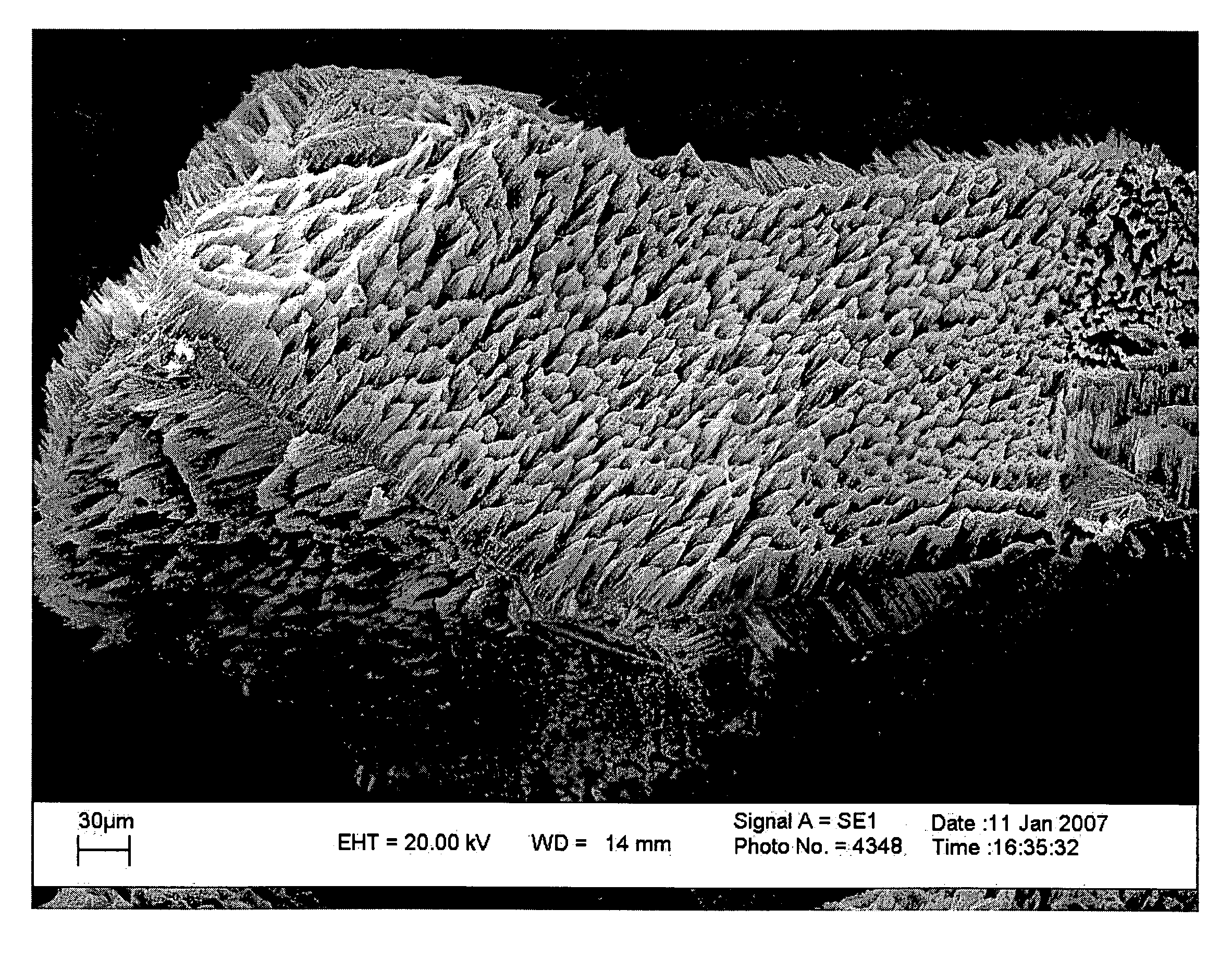A method of fabricating structured particles composed of silicon or a silicon-based material and their use in lithium rechargeable batteries
a structured particle and material technology, applied in the direction of positive electrodes, inorganic chemistry, decorative arts, etc., can solve the problems of not being commercially viable, not showing sustained capacity over the required number of charge/discharge cycles, etc., and achieves low cost and good quality. , the effect of simple operation
- Summary
- Abstract
- Description
- Claims
- Application Information
AI Technical Summary
Benefits of technology
Problems solved by technology
Method used
Image
Examples
example 1
To Obtain Pillar Particles
[0076]The reaction was conducted in a polyethylene container with 8 litre volume. A lid is provided that has a hole for introducing ingredients and a stirrer. The following reactants were used:
Silicon Powder—SiElkem Silgrain HQ J272.1, having aparticle size of 20-40 μm; largerparticle sizes were eliminated bysieving and washing the powder indeionised water 3 timesHydrofluoric acid—HF Aldrich Honeywell, 17735, 40%(w / w) semiconductor gradePURANAL ™AgNO3 / HNO3 solutionconcentrations of AgNO3 and HNO3are 2.56M and 3.65M respectivelySodium nitrate—NaNO3 Sigma-Aldrich, Anhydrous, crystalpowder, ACS reagent, ≧99.0%Sodium hydroxide—NaOHVWR BDH AnalaR, Lot B0138150734, Prod 102525P
[0077]The reaction was conducted at room temperature (10-25° C.). 35 ml of the AgNO3 / HNO3 solution containing. is mixed with 3 litres 7M HF solution in the reaction chamber and then 5.1 gram NaOH dissolved in 30 ml water is added. The resulting solution contains 0.0299M AgNO3.
[0078]20 gram ...
example 2
To Obtain Fibres
[0082]The reaction container and the reactants are the same as in Example 1. Again the reaction is conducted at room temperature since the reaction mixture does not get very hot.
[0083]40 ml of the AgNO3 / HNO3 solution is mixed with 3 litres 7M HF solution in reaction chamber then 5.9 gram NaOH dissolved in 30 ml water is added. The final solution contains 0.033M AgNO3.
[0084]20 gram Si powder (J272.1) is added through funnel at top of the container and the mass is gently stirred by hand, through the hole in the lid using a rod, for 1 minute. This reaction mixture is allowed to stand for 40 minutes. The “mat” of silicon plus silver forms on the surface of the etch solution in the first 1-2 minutes.
[0085]At the end of the 40 minutes, 14 gram NaNO3 (or 12 gram NH4NO3) is added. The NaNO3 or NH4NO3 is dissolved into 50 ml water and then added through funnel at top. Stirring the solution about 1 min after adding. The mixture is allowed to stand for a further 50 minutes. The...
example 3
Making an Anode
[0089]The pillared particles or fibres are used as the active material in a composite anode for lithium-ion electrochemical cells. To fabricate a composite anode, the pillared particles or fibres are mixed with polyvinylidene difluoride and made into a slurry with a casting solvent such as n-methylpyrrolidinone. This slurry can then be applied or coated onto a metal plate or metal foil or other conducting substrate for example physically with a blade or in any other appropriate manner to yield a coated film of the required thickness and the casting solvent is then evaporated from this film using an appropriate drying system which may employ elevated temperatures in the range of 50° C. to 140° C. to leave the composite film free or substantially from casting solvent. The resulting composite film has a porous structure in which the mass of silicon-based pillared particles or fibres is typically between 70 percent and 95 percent. The composite film will have a percentage...
PUM
| Property | Measurement | Unit |
|---|---|---|
| height | aaaaa | aaaaa |
| particle size | aaaaa | aaaaa |
| diameter | aaaaa | aaaaa |
Abstract
Description
Claims
Application Information
 Login to View More
Login to View More - R&D
- Intellectual Property
- Life Sciences
- Materials
- Tech Scout
- Unparalleled Data Quality
- Higher Quality Content
- 60% Fewer Hallucinations
Browse by: Latest US Patents, China's latest patents, Technical Efficacy Thesaurus, Application Domain, Technology Topic, Popular Technical Reports.
© 2025 PatSnap. All rights reserved.Legal|Privacy policy|Modern Slavery Act Transparency Statement|Sitemap|About US| Contact US: help@patsnap.com



